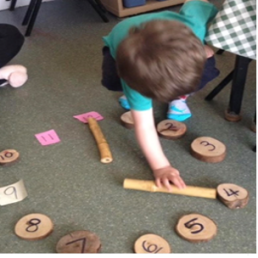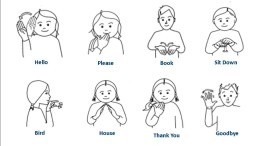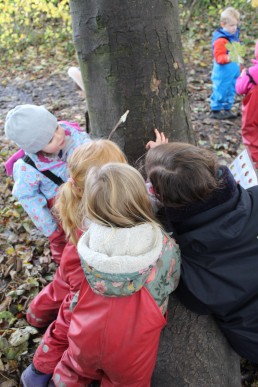Pre-school Maths
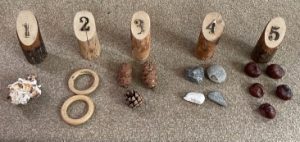
Mathematical development is complex. Developing a secure grasp of early mathematical ideas takes time. Even if a child appears to be engaging successfully in mathematical activities, such as reciting the count sequence, they may not understand the meaning of the numbers they are saying. It is important that practitioners are aware of typical development of mathematical skills and concepts and have the knowledge to support children’s understanding.
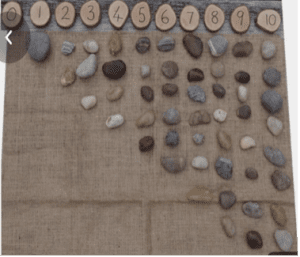 We at Inspirations have observed how beneficial the use of loose parts is for maths development. When children transform objects in their creative play, they are unknowingly problem-solving and building their imaginations. For example, when sticks and stones become food, mathematical concepts are natural encouraged as they assess the shapes, sizes and amounts they need. Often children will simply use loose parts to line up, order in size, number and make patterns.
We at Inspirations have observed how beneficial the use of loose parts is for maths development. When children transform objects in their creative play, they are unknowingly problem-solving and building their imaginations. For example, when sticks and stones become food, mathematical concepts are natural encouraged as they assess the shapes, sizes and amounts they need. Often children will simply use loose parts to line up, order in size, number and make patterns.
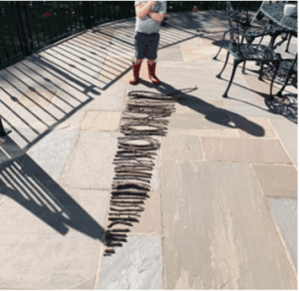 Pattern is extremely important for maths development. Recognising number through pattern and subitising (instantly recognising without counting) are skills we can help to develop by using a wide range of ideas and resources. Children will quickly recognise what the patterns on dice represent as numbers and progress to adding two sets of number patterns through board games and play.
Pattern is extremely important for maths development. Recognising number through pattern and subitising (instantly recognising without counting) are skills we can help to develop by using a wide range of ideas and resources. Children will quickly recognise what the patterns on dice represent as numbers and progress to adding two sets of number patterns through board games and play.
Dots seen in a regular pattern representing numbers has been used to support addition and subtraction in schools for many years.
. . .
. . = 7 . . = 3
. .
.
Eventually children become familiar with each number representation as they see these same patterns while recognising the shapes they make.
Numicon uses familiar shapes to represent numbers. Exploration of these resources at a young age will familiarise a child with their shapes and colours and eventually numbers will be assigned to each shape. As the shapes are 1-10 they can be used for ‘number bonds to ten’ by fitting the shapes together to form the 10th shape. They can also be used to support ‘adding beyond 10’ or ordering them as numbers and matching the numerals.
![]()
Conceptualising number through pattern can be supported in many other ways such as playing dominoes, using dice in a board game, playing cards or using tens frames.
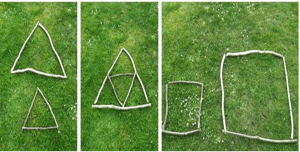 Challenges and activities to support maths progression can be planned regularly with adult support. Practitioners can work with children, sensitively intervening with questioning and prompts. Metacognition is the ability to reflect on your own thinking processes. Practitioners should encourage children to explain their thinking and strategies when solving mathematical problems. This enables children to gain an insight into their own thinking, learn from their mistakes, and develop problem-solving skills. Questions such as, ‘How did you…?’, ‘Why does this…?’, encourages children to reflect more deeply and to put their thought processes into words. Our practitioners seize chances to reinforce mathematical vocabulary in everyday situations. For example, by commenting on which child is standing ‘first’, ‘second’, or ‘last’ in line, which child has ‘more than’ or ‘fewer’ objects than another child and how many steps it takes to climb the stairs. The introduction of more refined mathematical vocabulary is then slowly increased through focused activities.
Challenges and activities to support maths progression can be planned regularly with adult support. Practitioners can work with children, sensitively intervening with questioning and prompts. Metacognition is the ability to reflect on your own thinking processes. Practitioners should encourage children to explain their thinking and strategies when solving mathematical problems. This enables children to gain an insight into their own thinking, learn from their mistakes, and develop problem-solving skills. Questions such as, ‘How did you…?’, ‘Why does this…?’, encourages children to reflect more deeply and to put their thought processes into words. Our practitioners seize chances to reinforce mathematical vocabulary in everyday situations. For example, by commenting on which child is standing ‘first’, ‘second’, or ‘last’ in line, which child has ‘more than’ or ‘fewer’ objects than another child and how many steps it takes to climb the stairs. The introduction of more refined mathematical vocabulary is then slowly increased through focused activities.
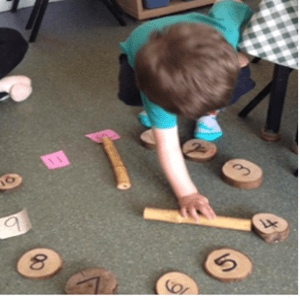 Physical whole-body movement and gestures support the learning of mathematics, for example, moving along a physical number line or jumping and clapping while counting. Practitioners should also encourage children’s use of fingers which are important manipulatives, initially useful for supporting counting and later for counting in groups.
Physical whole-body movement and gestures support the learning of mathematics, for example, moving along a physical number line or jumping and clapping while counting. Practitioners should also encourage children’s use of fingers which are important manipulatives, initially useful for supporting counting and later for counting in groups.
It is important to realise that not all maths activities need specific or specialised resources, anything can be counted and numbers can be formed with most materials. During Covid lockdown, Inspirations provided a virtual nursery and the first activity we suggested was to go for a walk and collect natural resources. These were then used in our future activities to ensure that all children could take part without having to purchase anything.
Maths opportunities are all around us. We should encourage learning in this area through numerical songs, games, activities and play, to help children develop a keen attitude for maths, so they can follow this interest when it becomes a lot trickier in formal school!
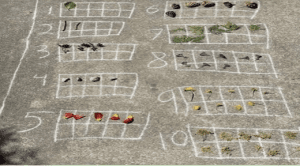
Deborah Keane
Other Ways to Communicate
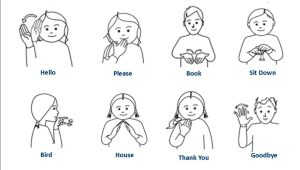
When we talk about communication people often only think about speech, but there are lots of different ways to communicate. Eye contact, body language, facial expressions, gestures, and drawing and writing are daily tools we might use for sharing information.
At Inspirations we follow the Reggio Emilia approach, where one of our key principles is the ‘hundred languages of learning’. The principle refers to communication and the one hundred ways children can express and process the world around them. It provides children opportunities to engage through arts and media, light and shadow and music.
At Inspirations we implement this approach through our daily sessions. The pre-school children decide where they would like to go at choosing times. They may choose to stay in the yurt and outdoor classroom, where the environment is carefully set up by trained staff which use the children’s interests to extend their learning, or they may decide to go off site. Our child-led curriculum provides forest school and art studio workshops twice a day, for two hours. Working in small groups in the art studio ensures that the children can work intimately on projects, expressing their thoughts and ideas through a diverse range of mediums. The forest school sessions provide a breadth of natural resources for the children, and with the guidance from trained staff, a world of beauty, connection, movement and autonomy.
Communicating in all the different ways may come easier to some people than others and some may find them all challenging. Some people may have conditions which can affect the way they communicate. For example, someone who is autistic will often have difficulties when it comes to communicating, especially in social situations. Some people struggle to verbally communicate so will need to learn other non-verbal methods.
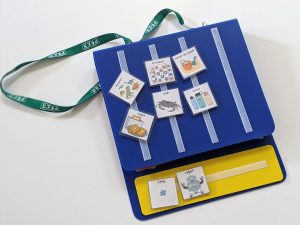 In our nursery each room is supplied with visual aids. This picture-based resource enables babies and children that are preverbal to interact with us. Visuals provide good support to a verbal instruction and help children to understand and make connections. When necessary, we also use Boardmaker which is a software often used across Leeds to support children with Special Educational Needs and Disabilities (SEND) as well as children with English as an additional language. Using resources that they may use when they move on from us is important for consistency. Some children may need PECS, which is a Picture Exchange Communication System. This is a unique communication tool using Boardmaker to enable children to communicate their wants and needs. The programme involves another person acting as the communicative partner, responding to the child's requests. It teaches children that communication is an exchange and how to put words together to form a sentence.
In our nursery each room is supplied with visual aids. This picture-based resource enables babies and children that are preverbal to interact with us. Visuals provide good support to a verbal instruction and help children to understand and make connections. When necessary, we also use Boardmaker which is a software often used across Leeds to support children with Special Educational Needs and Disabilities (SEND) as well as children with English as an additional language. Using resources that they may use when they move on from us is important for consistency. Some children may need PECS, which is a Picture Exchange Communication System. This is a unique communication tool using Boardmaker to enable children to communicate their wants and needs. The programme involves another person acting as the communicative partner, responding to the child's requests. It teaches children that communication is an exchange and how to put words together to form a sentence.
In our baby rooms we use Makaton during singing times and for other frequent words such as ‘more’ or ‘drink’. Makaton involves signing key words, using a spoken word at the same time. Although it is not an official form of signing, it is based on signs used in the British Sign Language. Makaton was developed for very young children with special needs or other communicative challenges. It is helpful for someone who can hear but has difficulties with communication as it uses symbols, verbal words and hand signs.
Kayleigh Woolger
The Benefits of Forest School
At Inspirations we value greatly our outdoor environments which are extensive and include the use of our local Horsforth woodland at Hunger Hills. Our passion for outdoor learning and forest school comes from a deep understanding and appreciation for the ethos. The pedagogy was developed in Sweden in the 1950’s and the approach focuses on the natural environment being utilised, not only as an area where children can blow off excess energy but more importantly where children are given the opportunity to immerse themselves in nature.

http://simonr30.sg-host.com/our-settings/forsest-school/
Forest school children develop an appreciation and deep seated love of nature and are able to explore and learn from all that the environment has to offer, at a pace that suits them.
'Lead their own Learning'
The forest school ethos allows for each individual child to lead their own learning journey. They find their own pace, interests and methods of learning and attainment that best suit them. There is no pressure, no preconceived results, no adults determining a beginning or end to their project or interest.
Adults of course play a vital role one which is supportive and patient, they build strong positive relationships which children know they can trust and count on. The Adults help children take managed risks encouraging children to consider, they ask questions and encourage with a hands-on approach which helps supports critical thinking.


Resilience and Determination
Forest school children are shown to be ahead of their peers by the time they start school at the age of five. They show confidence, are very willing to ‘have a go’ and not be deterred by failed attempts. They are resilient and eager to keep trying until they find a positive solution to a problem. It is shows they are effective problem solvers who work well within a team, exhibiting high levels of motivation and concentration to any task facing them.
The forest learning environment also creates strong communicators and gives children a deep level of understanding about the word around them. They are socially advanced, understanding feelings and consequences of their behaviour and are more likely to think before they act. Naturally children who spend time in wide open spaces where the floor is uneven, who have trees to climb and weather to navigate are more confident in their own physical abilities. They are more prone to want to be outdoors as adults and as a result are more healthier, happier individuals.


There are several studies on the benefits of forest school and outdoor learning philosophy. These studies are becoming more prevalent as the ethos has slowly become more popular. Below are a few links to the most recent studies showing the benefits mentioned in our blog above.
https://www.forestschoolassociation.org/new-research-a-longitudinal-study-on-forest-school/
- Nicola

